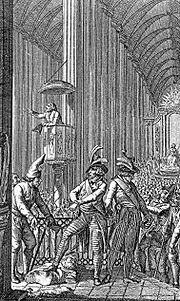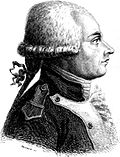- Cult of Reason
-
The Cult of Reason (French: Culte de la Raison)a was an atheistic belief system established in France and intended as a replacement for Christianity during the French Revolution.[1]
Contents
Origins
Opposition to the Catholic Church was integral among the causes of the French Revolution, and this anti-clericalism solidified into official government policy in 1792 after the First French Republic was declared. Most of the dechristianisation of France was motivated by political and economic concerns, but philosophical alternatives to the Church developed gradually as well. Among the growing heterodoxy, the structural concepts of the Culte de la Raison became defined by Jacques Hébert, Antoine-François Momoro, Pierre-Gaspard Chaumette, Joseph Fouché, and other radical revolutionaries.
Philosophy
The Cult of Reason was explicitly humanocentric. Its goal was the perfection of mankind through the attainment of Truth and Liberty, and its guiding principle to this goal was the exercise of the human faculty of Reason. Though atheism was at the core of the cult, it defined itself as more than a mere rejection of gods: in the manner of conventional religion, it encouraged acts of congregational worship. The cult fostered frequent devotional displays to the ideal of Reason. A careful distinction was always drawn between the rational respect of Reason and the veneration of an idol: "There is one thing that one must not tire telling people," Momoro explained, "Liberty, reason, truth are only abstract beings. They are not gods, for properly speaking, they are part of ourselves."[2]
Revolutionary impact
Adherence to the Cult of Reason became a defining attribute of the Hébertist faction. It was also pervasive among the ranks of the sans-culottes. Numerous political factions, anti-clerical groups and events only loosely connected to the cult have come to be amalgamated with its name.[3] The earliest atheistic public demonstrations ranged from "wild masquerades" redolent of earlier spring festivals to outright persecutions, including ransackings of churches and synagogues[4] in which religious and royal images were defaced.
Joseph Fouché
As a military commander despatched by the Jacobins to enforce their new laws, Fouché led a particularly zealous campaign of dechristianisation. His methods were brutal but efficient, and helped spread the developing creed through many parts of France. In his jurisdictions, Fouché ordered all crosses and statues removed from graveyards, and he gave the cult one of its elemental tenets when he decreed that all cemetery gates must bear only one inscription – "Death is an eternal sleep."[5] Fouché went so far as to declare a new civic religion of his own, virually interchangeable with what would become known as the Cult of Reason, at a ceremony he dubbed the "Feast of Brutus" on 22 September 1793.[6]
Festival of Reason
The official nationwide Fête de la Raison, supervised by Hébert and Momoro on 20 Brumaire, Year II (10 November 1793) came to epitomize the new republican way of religion. In ceremonies devised and organised by Chaumette, churches across France were transformed into modern Temples of Reason. At Notre Dame in Paris was the largest ceremony of them all. The Christian altar was dismantled and an altar to Liberty was installed; the inscription "To Philosophy" was carved in stone over the cathedral's doors. The proceedings took several hours and concluded with the appearance of a Goddess of Reason who, to avoid idolatry, was portrayed by a living woman.[7]
Many contemporary accounts reported the Festival of Reason as a "lurid", "licentious" affair of scandalous "depravities",[8] although some scholars have disputed their veracity.[9] These accounts, real or embellished, galvanized anti-revolutionary forces and even caused many dedicated Jacobins like Maximilien Robespierre to publicly separate themselves from the radical faction.[10]
Legacy
In the spring of 1794, the Cult of Reason was faced with official repudiation when Robespierre, nearing complete dictatorial power, announced his own establishment of a new, deistic religion for the Republic, the Cult of the Supreme Being.[11] Robespierre denounced the Hébertistes on various philosophical and political grounds, specifically rejecting their atheism. When Hébert, Momoro, Ronsin, Vincent and others were sent to the guillotine on 4 Germinal, Year II (24 March 1794), the cult lost its most influential leadership; when Chaumette and other Hébertistes followed them four days later, the Cult of Reason effectively ceased to exist. Both cults were officially banned by Napoleon Bonaparte with his Law on Cults of 18 Germinal, Year X.[12]
See also
- Cult of the Supreme Being
- Dechristianisation of France during the French Revolution
- Reign of Terror
- Religion of Humanity
Notes
- ^ a: The word "cult" in French means "a form of worship", without any of its negative or exclusivist implications in English; its proponents intended it to be a universal congregation.
References
- ^ Fremont-Barnes, Gregory (2007). Encyclopedia of the Age of Political Revolutions and New Ideologies, 1760–1815. Greenwood Press. ISBN 0313334455. http://books.google.com/books?id=6_2wkP4j-EsC&dq.
- ^ Kennedy, Emmet (1989). A Cultural History of the French Revolution. Yale University Press. p. 343. ISBN 0300044267. http://books.google.com/books?id=QhyjQgAACAAJ&dq=A+Cultural+History+of+the+French+Revolution&hl=en&ei=Q4NCTJ7KH4O78gbmwvgL&sa=X&oi=book_result&ct=result&resnum=1&ved=0CC4Q6AEwAA.
- ^ Kennedy, p. 343: "The Festival of Reason... has come to symbolize the Parisian de-Christianization movement."
- ^ Goldstein, Morris (2007). Thus Religion Grows – The Story of Judaism. Pierides Press. ISBN 1406773492. http://books.google.com/books?id=NQ6tn8NlHucC&printsec=frontcover&hl=ru#v=onepage&q&f=false.
- ^ Doyle, William (1989). The Oxford History of the French Revolution. Clarendon Press. p. 259. ISBN 0198227817. http://books.google.com/books?id=f5JfQgAACAAJ&dq=The%20Oxford%20History%20of%20the%20French%20Revolution&source=gbs_book_other_versions. "Fouché declared in a manifesto... graveyards should exhibit no religious symbols, and at the gate of each would be an inscription proclaiming Death is an eternal sleep."
- ^ Doyle, p. 259: "[Fouché ] inaugurated a civic religion of his own devising with a 'Feast of Brutus' on 22 September at which he denounced 'religious sophistry'."
- ^ Kennedy, p. 343: "A 'beautiful woman' was chosen... rather than a statue, so that she would not become an idol".
- ^ Kennedy, p. 344: "The Festival of Reason in Notre Dame left no impression of rationality on the memories of contemporary observers.... [I]t was evident that the Festival of Reason was a scandal."
- ^ Ozouf, Mona (1988). Festivals and the French Revolution. Harvard University Press. pp. 100ff. ISBN 0674298845. http://books.google.com/books?id=iq6yuKS6EWEC&printsec=frontcover&dq=Mona+Ozouf&hl=en&ei=RAtVTPvwD4L58Aa3m7SRBQ&sa=X&oi=book_result&ct=result&resnum=1&ved=0CCgQ6AEwAA#v=onepage&q&f=false.
- ^ Kennedy, p. 344: "...tales of its raucousness may have contributed to Robespierre's opposition to de-Christianization in December 1793."
- ^ "War, Terror, and Resistance". Center for History and New Media, George Mason University. http://chnm.gmu.edu/revolution/chap7c.html. Retrieved 26 March 2011.
- ^ Doyle, p. 389.
Categories:- Religion and the French Revolution
- Religion in France
- 1792 events of the French Revolution
- 1793 events of the French Revolution
- 1794 events of the French Revolution
- Anti-Catholicism in France
- Atheism
Wikimedia Foundation. 2010.





